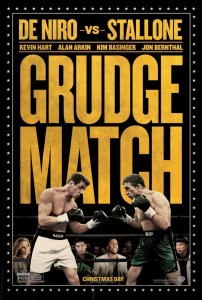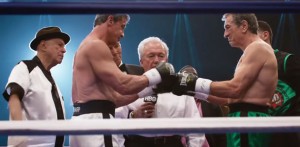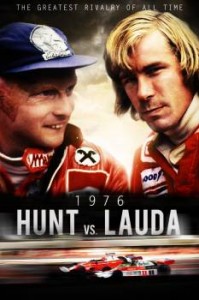
Not that this is going to come as a surprise to anyone, but this movie is not just bad, it is sad. The stars of two of the greatest boxing movies of all time are not just slumming here. They trash their pasts and ours, too, with a bunch of jokes about prostates, jock itch, hookers, the financial rewards of Kardashian sex tapes, and what “BJ” stands for. If you think it is hilarious for a father and grandfather tell a child that “BJ” stands for butterscotch jellybeans — wink wink nudge nudge — then this is the movie you’ve been waiting for. Oh, and a prison rape joke. When the end credits list the roles in the film as “tranny hooker” and “puking boxer,” you get the idea. Plus, there’s an extended scene with a bucket of horse urine.
“Razor” Sharp (Sylvester Stallone from “Rocky’) and Kid (Robert De Niro from “Raging Bull”) play former light heavyweight champions who fought each other twice, one win for each. They bitterly dislike each other for personal and professional reasons. But they agree to throw some punches for a computer game. Footage of them scuffling at a video game studio in green motion capture suits goes viral and the impulsive and ambitious son of their former promoter (Kevin Hart) persuades them to fight each other for real. Cue the training montage and the jokes that ended up on the cutting room floor from “Grumpy Old Men.”

Razor agrees to the fight because he needs the money. He is broke, losing his job, and caring for his old trainer (Alan Arkin). Kid agrees to fight because he wants to win. He’s doing fine financially, with a car dealership and a bar called “Knock Out.” In one of several sad, soggy call-outs to previous greatness, his shtick-y puppet routine in the bar is a reminder of the brilliant end of “Raging Bull,” when an overweight Jake LaMotta tries to perform in his nightclub. It still rankles him that he lost the last bout with Razor and he is sure he can win this time.
Kim Basinger shows up as the real reason for the feud. And there’s a long-lost son who happens to be just the guy to get Kid back in shape, starting with getting the fighter to stop those breakfasts of Scotch and pancakes. The son’s name is BJ and he is played by John Bernthal, the only person in this movie who comes off with any class and dignity, even when the script calls for him to forgive a man whose idea of babysitting is to take a child to a bar while he goes off to have sex with someone he just met in the parking lot. Poor Alan Arkin for the second time in 2013 is stuck with the role of the guy who insults the staff at his assisted living facility and is supposed to be funny just because it’s an old guy being crude.
There are many, many jokes about how old these guys are. They are bad. There are winking references to their better work. They are awful. So is this movie.
Parents should know that this movie includes extremely crude sexual references and very strong and vulgar language for a PG-13, as well as a car crash and boxing violence with some graphic images of injuries.
Family discussion: Why does Kid want to fight? Who were you rooting for and why?
If you like this, try: “Rocky” and “Raging Bull”



